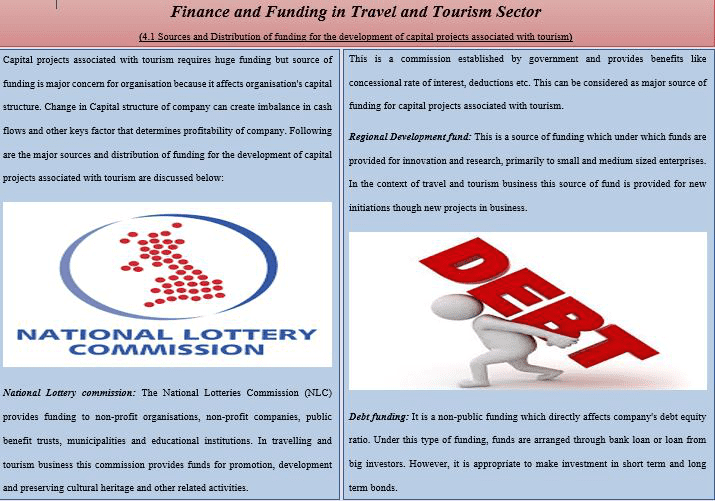INTRODUCTION
Finance is a field that is concerned with the allocation of assets and liabilities over space and time under conditions of risk and uncertainty. It is considered as lifeblood of every organisation that helps businesses to survive in long run. A valuable amount of funds is required to operate various business operations (Ambrose, 2012). Finance and funding in travel and tourism is one of the primary concern on the basis of which all the future plans are designed. Through the act of funding financial resources are provided to different business concerns. Through this project report understanding of cost, volume and profit of management accounting information in travel and tourism sector is provided. Pricing methods and factors influencing profits are mentioned. Together with this various sources of funding in this sector and required skills to interpret financial accounts is mentioned in the report.
TASK 1
1.1 Importance of cost and volume in financial management of travel and tourism business
There is a rapid growth is noticed in travel and tourism industry over the period of time. Contribution of this industry towards Gross Domestic Products of the country is increasing. It is considered as one of the largest revenue contributing sector in UK. Growth in travel and tourism helps in development of infrastructure sector in the country. Together with this one of the important contribution is towards creating wealth by generating maximum job opportunities during an accounting period (Gibson, Kaplanidou and Kang, 2012). Growth in this sectors helps government to resolve one of the major social issues like employment. Providing employment leads to more income and higher standard of living. Carnival plc London, England is working in travel and tourism sector. As working in this company it is important to understand cost, volume and profit for management decision making by the organisation.
Relationship between cost, volume and profit makes up the profit structure of an enterprise. CVP relationship becomes essential for budgeting and profit planning. As an ultimate object of Carnival plc it helps management to find the most profitable combination of cost and volume. Importance of cost and volume in financial management through CVP analysis is as follows:
Cost volume and profit analysis explains the behaviour of profits in response to a change in cost and volume. Carnival plc is related to travel and tourism business and to calculate impact of cost and volume on profits understanding CVP analysis is important. Similar to other organisations Carnival plc also possess targets to earn revenue in a particular financial year. To achieve targeted objectives it is important to identify level of sales volume that needs to be made to achieve targeted objective. Sales made at the level where cost incurred is equal to revenue then it is a situation of break-even-point. To have insight into the effects and inter-relationships of factors which influence profits it is important to understand contribution of cost and volume. Cost is the amount that is incurred by Carnival plc to provide services to consumers. Higher cost leads to expensive services and minimise consumers attraction (Guttentag, 2015). It is important to manage cost for the product and services provided by the organisation to maximise profits. Cost and volume possess reverse relationship as higher the cost will leads to low volume of sales. On the other hand low cost will bring higher sales volume and target to earn more revenue will be achieved by Carnival plc. Cost in providing services for travel and tourism sector can be direct, indirect and fixed cost. For effective financial management allocation of cost must be available with Carnival plc to take productive decisions.
BEP analysis is a effective aspect that helps Carnival plc to determine amount of total sale and profit position of the company. It helps in determine sales volume that is required to attain target objective of earning profits. Economies of scale helps business organisations to gain competitive advantage by reducing cost per unit. For financial management CVP analysis is important as it helps in-
- Improving performance: It helps in enhancing ability of Carnival plc by effective management through accurate information regarding cost and volume of the company.
- Decision making: Planning for future is based on information provided and effective planning helps in good decision making that contribute towards attainment of targeted objectives (Wanhill, 2013).
1.2 Pricing method used in travel and tourism sector
Carnival plc uses various pricing strategies when selling services to variety of consumers. The price can be set to maximize profitability for each unit sole or from the market overall. An effective pricing helps business in travel and tourism sector to defend an existing market from new entrance. Price is considered as one of the effective tool that gives competitive advantages to organisations. Pricing of a product depends on variety of things such as type of business, targeted consumers, cost incurred. For tourism businesses setting price will be more market based. Price for Carnival plc will be set to ensure that profits are available on each sale. Following pricing methods are used by Carnival plc for its future-
- Mark down pricing strategy: When selling prices are deliberated and reduced then it is termed as mark down pricing strategy. This pricing strategy is used by Carnival plc in order to remain competitive. When sales are slow then it is considered as one of the effective method to boost up sales. This helps to generate more bookings and more revenue will be earned by organisations.
- Packages: Packages are highest in trend as largely appreciated by travellers all over the world. This helps to meet needs such as hotels, airfare, transfers, tours and all activities are for inclusive price. Developing packages with complementary tourism is a good way to stimulate demand and add value without having to discount. Packages are used to target niche markets effectively. Adopting this strategy will help Carnival plc to earn well.
- Seasonal pricing: Different prices are charged throughout the year to cover low and high seasons. Usually there are some days in a year in which sales are high and for some days sales are low. Charging price as per different season will help to recover cost because of off season. Carnival plc will adopt this strategy during holiday period to become competitive (Kimbu and Ngoasong, 2013).
- Last minute pricing: A common pricing strategy for accommodation suppliers and tour operators to fill any last minute gaps. It involves discounting prices according to take-up which are then promoted on last minute booking website. It helps to fill vacant seats and brings company in break even situation despite of loses. Carnival plc will use this strategy to have complete its bookings to be at break even point.
- Discounting: Discounts are used in off seasons or to assist yield management but this strategy must be selective as over use of this can reduce profitability. It is reliable strategy for Carnival plc in order to deal with competition.
|
Particulars |
Amount |
|
Sales price per consumer |
15000 |
|
Less: Variable cost |
|
|
Meal charges |
2500 |
|
Contribution |
12500 |
|
Fixed cost |
1500000 |
|
Total number of consumers |
160 |
|
Total profits |
2000000 |
|
Desired profits |
500000 |
1.3 Factors influencing profits for travel and tourism business
In the fast changing environment there are various factors that are affecting businesses. It is essential for Carnival plc to determine different factors that affects and influence profits for tourism industry (Koutra and Edwards, 2012). There are positive and negative aspects of each factor that needs to determine profit earning capacity of an organisation. Factors that are influencing profits of Carnival plc are as follows-
Events: when a destination has special event like holiday markets, annual festivals on large scale or Olympics then travel marketing is ratcheted up accordingly. This increased and grab attention of public at large scale through social media and news channels. This is turned as marketing for tour and travelling company and attracts large number of consumers. When Carnival plc is choosing event place as their destination then it will leads to attract large consumer group and brings more profits for the company.
Seasons: Most travel destinations and related tourism products have at least one set of high and low seasons. In off seasons it brings lower rates through cheaper flights and less interest overall. In peak season cost related to each area increases. To deal with increased pricing in peak season Carnival plc will use marketing plan with a heavy high season and light low season spending budget. This affects amount of marketing that takes place during each period as well as type of marketing.
Currency Rates: Travelling internationally is very mush affected by currency fluctuations in the currency rates between countries. A positive fluctuation will boost travelling business and eventually profits of Carnival plc will get hike. When fluctuations are negative then it will affects travel and tourism businesses by reducing income (Von der Weppen and Cochrane, 2012).
Government: In many cases, government-run tourism boards that are sole source of funding for a travel and tourism marketing campaign. Government of a country plays important role in boosting tourism sector of the country through development of infrastructure. Annual budgets for this sector by government gives business organisations like Carnival plc fair chance to increase business and have large share in profits.
TASK 2
2.1: Analysing various types of management accounting information that can be used in Fulham Shore plc:
In a business organisation tasks and activities are efficiently performed or organised by using management accounting information and information obtained from management accounting process are used by management to design new and improved tasks or activities. Management accounting assists in establishing proper control over activities whether internal or external, on regular basis (Morrison, 2013). It also helps in identifying any possible events which can create difficulties in organisation's operation in near future. Following are the various type of management accounting information, as follows:
Cost allocation report: This report contains detailed information related to cost allocated to each and every task or activities of business organisation. By using this report management can find out cost of each activity during a particular period or event. These type of report provides details regarding costs assigned to particular segment and optimise particular cost as per requirements.
Budget report: It is very common but important report prepared by management to estimate and allocate cost as per budget or standard. Budget reports are prepared to achieve short term objectives of company. In case of business organisation having different segments, estimated cost for each segments while classifying their activities are determined according to the budget report.
Job cost reporting: In job cost reporting cost of each job or task are defined along with scheduled time of task and also contains information related to cost of delay in completion of particular task or job.
Management of Fulham Shore plc can use all these above mentioned information in order to establishing a systematic control on activities of organisation and to enhance and achieve targeted performance and goals (Zapata and Hall, 2012). Management should use these information for reporting purpose in order to formulate a systematic chain of communication between various various department within the organisation.
2.2: Assess the use of management accounting information as a decision-making tool:
Management accounting information is play a major role in decision making process by providing relevant information for decision makes like owners, managers, top level management etc. Management accounting information includes classified information that need no additional analysis so decision makers can use these information directly to take any financial decision (Nicula, Spanu and Neagu, 2013). These information also assists in planning, budgeting and estimating process. In the context of Fulham shore plc following points describes use of such information in decision-making:
- Comparative analysis: Management accounting information provides a comparative analysis of information which can be used by Fulham as a tool for decision-making because comparative analysis provides a measure for interpreting relationship between data of two or more periods.
- Forecasting: Management accounting information creates a basis for estimating or projecting performance of an business organisation. In Fulham to determine the objectives and to take decision based on objectives of company for short term, management accounting information provides forecasting as a tool of decision-making.
- Make-or-buy Decisions: Management accounting information gives information which assists organisation to choose either to perform activities or outsource. If outsourcing is beneficial then performing activities can reduce profits of organisation (Petković and Pindžo, 2012). In Fulham some products are purchased and some are entirely provided by company through their stores, such type of decisions are taken by management using management accounting information.
- Analysis of Rate of Return: Before launching new project every organisation conduct analysis of the expected rate of return (ROR) to ascertain viability of project or whether there is another option is available. In Fulham this analysis by using management accounting information is useful in case of decision related to launching of new product. For example there is some illustrated data is taken to calculate accounting rate of return:
|
Year |
Cash flows |
PV factor |
Net present value |
|
0 |
-20000 |
1 |
-20000 |
|
1 |
9850 |
0.9090909091 |
8954.55 |
|
2 |
9500 |
0.826446281 |
7851.24 |
|
3 |
6500 |
0.7513148009 |
4883.55 |
|
4 |
5500 |
0.6830134554 |
3756.57 |
|
NPV |
11350 |
|
5445.9 |
|
Internal rate of return |
23.56% |
||
- Strategic decisions: Information generated in management accounting process assist management to take strategic decisions. In Fulham by using such information a strategy for selling of products can be decided.
TASK 3
3.1: Interpretation of ratios in travel and tourism financial accounts
Interpretation of financial statement by using ratios
Process of data collection is considered to plan an appropriate model of workflow (Page, 2014). Financial statement analyst view balance sheet, income statements and more documents for evaluating the financial accounts of The Fulham Shore plc and compute and analyse different ratios that are mentioned below:
|
Ratios |
Formula |
2016-17(in million) |
2017-18(in million) |
|
1. Profitability ratios: |
|
|
|
|
· Gross profit ratios |
Gross profit/Sales*100 |
18/41*100 =43.90% |
23/55*100 =41.81% |
|
· Net Profit margin ratio |
Net profit/sales*100 |
1/41*100 =2.43% |
0/55*100 =0% |
|
2. Liquidity ratios: |
|
|
|
|
· Current ratio |
Current assets/current liabilities |
4/14 =0.28:1 |
6/12 =0.5:1 |
|
· Quick ratio |
Quick assets/ current liabilities |
Quick assets = 0+1=1 1/14 =0.07:1 |
Quick assets= 0+1=1 1/12 =0.08:1 |
|
3. Investment ratios: |
|
|
|
|
· Return on Equity |
Net income/ Average stockholder's equity*100 |
1/19.5*100 =5% |
-1/19*100 =-5% |
|
· Return on Assets |
Net profit/ Total assets*100 |
1/61*100 =1.63% |
0/65*100 =0% |
Gross profit ratio:
This ratio exhibits the percentage of profit after cost of goods sold i.e. gross profit in comparison to total revenue (Smith, 2012). It points outs profit figure of company earns after cost of goods sold. The Fulham Shore plc has gross profit ratio of 43.90% in 2016-17 and 41.81% in 2017-18 which shows a negative decrease in gross profit of company.
Net profit margin ratio:
The Fulham Shore plc has net profit ratio of 2.43% in 2016 and no net profit in 2017-18 which shows that company's efficiency to generate net profit has been decreased.
Current ratio:
It describes efficiency of business to pay debts due during a particular period out of current assets. Ideal current ratio is 2:1. Fulham Shore plc has current ratio: 0.28:1 in 2016-17 and 0.5:1 in 2017-18 which is less than the ideal ratio of 2:1 showing unfavourable trend.
Quick ratio:
Ideal quick ratio is 1:1, quick ratio above 1:1 shows that the business can meet its current financial obligations by using its quick assets on hand and quick ratio lower than 1:1 shows that company has high dependence on inventory or other assets to pay its short-term liabilities. The Fulham Shore plc has quick ratio: 0.07:1 in 2016-17 and 0.08:1 in 2017-18 which is bwlow the ideal ratio and considered as unfavourable.
Return on equity:
The return on equity ratio is type of a profitability ratio that shows efficiency of organisation to earn profits from its shareholders investments. ROEs of 15-20% are normally considered as favourable. The Fulham Shore plc has return on equity: 5% in 2016-17 and -5% in 2017-18, which is showing a decrease in company's efficiency to generate income from its shareholders.
Return on assets:
The return on assets ratio shows company's effectiveness in relation to earn a return on its investment in assets. Fulham Shore plc has return on assets of 1.63% in 2016-17 and null ratio in 2017-18 due to no net profit, which shows a decrease in company's effectiveness to generate income from assets.
TASK 4
4.1: Sources and distribution of funding for the development of capital projects associated with tourism

CONCLUSION
From this report it is concluded that minor decision related to finance and funding have great impact on performance and profitability of company. To take such type of vital decisions management should consider different techniques and analysis like ratio analysis, analysis of pricing methods, forecasting etc. Information used in management accounting information assists in assessment of company's efficiency and effectiveness in monetary terms.
Are you tired of wasting countless hours trying to write the perfect Tourism Assignment? Gift yourself some peace of mind along with quality time spent however you want, take professional tourism assignment writing help to achieve desired grades.
REFERENCES
- Ambrose, I., 2012. European policies for accessible tourism. Best practice in accessible tourism: Inclusion, disability, ageing population and tourism, pp.19-35.
- Gibson, H. J., Kaplanidou, K. and Kang, S. J., 2012. Small-scale event sport tourism: A case study in sustainable tourism. Sport management review. 15(2). pp.160-170.
- Guttentag, D., 2015. Airbnb: disruptive innovation and the rise of an informal tourism accommodation sector. Current issues in Tourism. 18(12). pp.1192-1217.
- Kimbu, A. N. and Ngoasong, M. Z., 2013. Centralised decentralisation of tourism development: A network perspective. Annals of Tourism Research. 40. pp.235-259.
- Koutra, C. and Edwards, J., 2012. Capacity building through socially responsible tourism development: A Ghanaian case study. Journal of travel research. 51(6). pp.779-792.
- Morrison, A. M., 2013. Marketing and managing tourism destinations. Routledge.
- Nicula, V., Spanu, S. and Neagu, R. E., 2013. Regional tourism development in Romania-consistency with policies and strategies developed at EU level. Procedia Economics and Finance. 6. pp.530-541.
- Petković, G. and Pindžo, R., 2012. Tourism and new economic challenges. Ekonomika preduzeća. 60(1-2). pp.117-126.
- Smith, K., 2012. The problematization of medical tourism: a critique of neoliberalism. Developing world bioethics. 12(1). pp.1-8.
- Spenceley, A., 2012. Responsible tourism: Critical issues for conservation and development. Routledge.
- Von der Weppen, J. and Cochrane, J., 2012. Social enterprises in tourism: An exploratory study of operational models and success factors. Journal of Sustainable Tourism. 20(3). pp.497-511.
- Wanhill, S., 2013. Government assistance for tourism SMEs: from theory to practice. In Small Firms in Tourism (pp. 63-80). Routledge.
- Zapata, M. J. and Hall, C. M., 2012. Public-private collaboration in the tourism sector: balancing legitimacy and effectiveness in local tourism partnerships. The Spanish case. Journal of Policy Research in Tourism, Leisure and Events. 4(1). pp.61-83.



 Company
Company


















